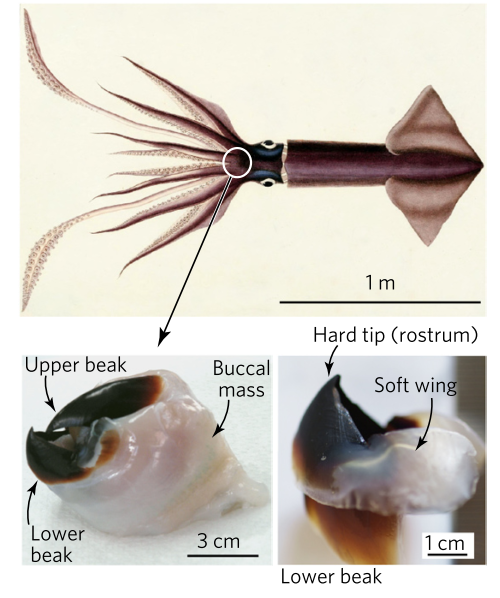Table of Contents
Internship @ NTU
I performed an internship at Nanyang Technological University (NTU) in Singapore in 2017. I performed this research under supervision of Ali Miserez and Bartosz Gabryelczyk in the Biological and Biomimetic Materials Laboratory.
In this project, I studied the proteins that couse coacervation inside the beak of giant squids. A paper containing my work (and quite a lot of other stuff) was published in Nature Communications if you want to check it out.
If you want a short(-ish) readable, understandable version of what I did, hopefully understandable for laymen, keep reading!
A Squid and its Coacervates
The formation of a water-immiscible liquid through the association of macromolecules, or ‘coacervation’, happens a lot in the natural world. It is present at all length scales: from adhesives used by marine animals, like barnacles and sandcastle worms, to the packing of DNA in the cell. In this project, I studied the coacervates and related structures found in the beak of the Dosidicus gigas squid.

The squid beak has fascinating mechanical properties: the beak is extremely strong: strong enough to break the shells of crustaceans it feeds on. On top of that, from the beak base to the hard tip (the ‘rostrum’) a 200-fold stiffness gradient is found. The ‘classic’ approach to building though materials in nature is the use of minerals. However, the squid makes use of another system altogether: the strength and gradient of the material are a result of the infiltration of a chitinous ‘framework’ of the beak with a network formed by proteins. The beak base has a high water content and low protein content, while the tip is almost water-less and a high protein content.
Biomolecular gradients, like the one found in squid beak, are efficient at preventing mechanical damage at interfaces. Failures in engineering multi-component systems are often due to mechanical property mismatches between various components. Therefore, natures solution for mitigating mismatch problems can potentially improve multicomponent system durability. For example, prosthetic limbs set directly in bone can benefit from a transition zone from soft tissue to the titanium prosthetic.
On top of this, coacervates have attracted attention due to their potential in biomedical applications as drug carrier or contrast agent. A better fundamental understanding in the different driving forces underlying coacervation is essential to design and improve these carriers, their biocompatibility and their responsiveness.
On closer inspection, the coacervates found in squid beak are not always truly coacervates. The proteins sometimes self-assemble into a hydrogel-like fibrillar network. The self assembly of proteins is relevant, as they could be used to built new functional materials. Protein fibrils in particular are the subject of intense study, because a class of protein fibrils (amyloids) are involved in Alzheimer’s and Huntington’s disease. Other examples of protein fibre include spider silk.
How Does the Squid get Nice Coacervates
In this project, I studied the ‘DgHBP’ protein to explain its self-coacervating and self-assembling behaviour. I specifically studied 2 types of DgHBP proteint which look largely the same. However, their self-coacervating behaviour is different. In seawater, one will form a dispersed coacervate - the solution will turn milky white due to the phase separation of the solution into a protein-poor phase and protein-rich microscopic droplets. The droplets will sediment into a single macroscopic coacervate phase at long time scales. The other will produce a fibrillar network- a hydrogel-like substance. In this project, I tried to show that the proteins that cause coacervation or a fibrillar network consist all contain a set of standard motifs. These parts of the proteins are clearly nessecary for making coacervates, while the rest seems less interesting. These motifs are repeated a few times within the protein. If you build new, small proteins that only contain these repeats (and very little other things), they can still make coacervates. Therefore, if you know if this repeating motif is present in the protein, and how many times, you can pretty accurately predict what the behaviour of the protein is going to be. The parts of the protein outside of these repeating motives seem to be more filler than anything else. In fact, the entire protein seems pretty unstructured, which is atypical for a protein.
This finding is nice, because it means we can look at at different proteins in different species, and predict if the proteins are also going to form coacervates. On top of that, we may want to start designing our own coacervate proteins, as they are quite interesting materials to have at your disposal.